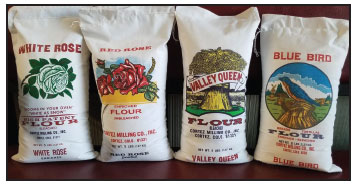 My ongoing foray into foodie literature took me to the latest book by Bill Buford, titled Dirt. One of the premises of this book is that the amazing bread from the bakery across the street from the author’s apartment in Lyon, France, is based on an unexpected source.
My ongoing foray into foodie literature took me to the latest book by Bill Buford, titled Dirt. One of the premises of this book is that the amazing bread from the bakery across the street from the author’s apartment in Lyon, France, is based on an unexpected source.
The extraordinary taste and texture of the baguettes produced by Monsieur Bob was not the yeast, his French kneading technique, or even the flour. It was the wheat grown on small family farms in the dirt of a particular valley above Lyon.
Somehow that sounded familiar. As I drove past the thresher harvesting wheat from a 40-acre field just a mile from my house – it struck me. Eureka? That’s what happens here… in Cahone… with dryland winter wheat. Could I write a book about the bread produced by our local wheat products? It would be easier if we had a local bakery, but I could at least write a column about the baked goods produced locally by home bakers like me.
Digging into the local wheat story, I found that the Hard-Red Winter wheat grown here is considered an “old-fashioned” variety compared to the new-fangled higher yielding species.
Its protein content (the all-important value to sourdough bread makers) is in the range of 10 to 13 percent. It is generally grown dryland, receiving only the moisture that is brought to the fields by Mother Nature. And in 2020, that was a scant few inches, making yields rather low about 10 bushels per acre. In Cahone, winter wheat is grown in rotation with pinto beans and sometimes sunflowers. The same field changes color every year – either green with beans, beige with wheat, yellow with sunflowers, or red with fallow dirt. Much like the Native American wheel of the four directions.
Like the dryland beans, this wheat seems to miraculously sprout out of the red dirt. In fact, the wheat planted a month ago was already emerging as slender green shoots, long before the first snow graced the fields.
One word I heard used to describe this wheat and the farmers who grow it in the cold and high-altitude of Southwest Colorado is “rugged.”
The wheat grown around Cahone is generally stored and “sweated” at High Country Elevator in Dove Creek. After about six months to a year, the now “cured” wheat is sold to the mill in Cortez and transformed into the well-known and beloved Bluebird and other flours. It’s hard to imagine that this rugged wheat is used exclusively to produce delicate Indian fry bread. For me, it took a book about French bread to learn to value these flours for more than the fabric sacks packaging with old-tyme graphics. They are a unique food experience that is grown, milled, and baked above 6500 feet. Perhaps I could coin a new tag line, “Never falls below 6500 feet!”
BTW, what’s with the Dutch windmill behind the bluebird on the flour sack image anyway? Does it have some secret meaning like the eye and pyramid on the dollar bill?
Just like the rugged wheat farmers loyal to their wheat variety and dryland growing techniques, local bakers are loyal to their Cortez Milling Company flour product. We all know that Bluebird flour is used to make Indian fry bread, but I have found that it also makes a wonderful and reliable pie crust and delicious doughnuts found at the Cortez Farmers’ Market.
Red Rose (the unbleached flour) is favored by local bread makers. Valley Queen is preferred for cakes and cookies. However, White Rose is preferred by the bakers in Red Mesa. A funny color choice when you think about it and supposedly, it is the same flour as Valley Queen, just in a different sack.
Cortez Milling also produces some specialty products from the local wheat including whole wheat flour and wheat germ, a breakfast comfort food of many old timers. With all the swirling unrest to cause indigestion, I am thinking of giving it a try myself.
So next time you bite into a Navajo taco or local loaf of green chili bread, see if you can taste the residue of past bean and sunflower crops. Or the lingering flavor of ancient civilizations blown in from the west.
Honor the ruggedness of the wheat growers and the determination of local bakers by shopping locally. Keep our Cortez mill alive and thriving. Eat Red Dirt!
Carolyn Dunmire cooks, gardens, and writes from Cahone, Colo.

